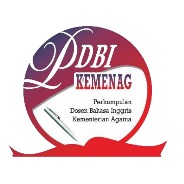The Vocabulary Profile of UN (Ujian Nasional) Reading Texts of Senior High School
Abstract
ABSTRACT
This the study was aimed at investigating vocabulary profile of English UN 2015 Reading Texts for Senior High School. Content analysis was used as a research method. The data were vocabularies which encountered within 14 reading texts. The instruments were Lewis (1997) divisions of lexical items adapted in Lakshmi (2012) and 1000-3000 new general service list by Browne and Coxhead (2013) within Vocab Profiler software inventing by Cobb (2009).The result showedthat(1) There were four lexical items encountered in the UN 2015 Reading Text. They were: polywords, collocation, a fixed expression, and semi-fixed expression. (2) The most dominant of lexical items were encountered in the Reading Text is collocation with 145 words (60%), Polywords with 51 words (21%), Semi fixed expression with 38 words (16%) and the lowest was fixed expression with 7 words (3%). (3) There were 1067 words (88%) in the UN reading text were the extent of coverage level 1000-3000 NGSL and NAWL level by Browne and Coxhead. The conclusion was the teacher should teach the students about collocation and other word partnership in order to assist students to comprehend the English text better.
Keywords
Full Text:
PDFReferences
REFERENCES
Bowey, J. A. (2005). Predicting individual differences in learning to read. The science of reading: A handbook, 155-172.
Browne, C., Culligan, B., & Phillips, J. (2013). The new general service list: A core vocabulary for EFL students and teachers. JALTs The Language Teacher, 34(7), 13-15.
Cobb, T. (2007). Computing the vocabulary demands of L2 reading. Language Learning & Technology, 11(3), 38-63.
Coxhead, A. (2000). A new academic word list. TESOL quarterly, 34(2), 213-238.
Cunningham, J. W. (2001). The national reading panel report. Reading Research Quarterly, 36(3), 326-335.
Fromkin, V., & Rodman, R. Hyams,(2007). An introduction to language, 8th ed. Boston: Thomson Wadsworth.
Hatch, E., & Brown, C. (1995). Vocabulary, Semantics, and Language Education. Cambridge University Press, 40 West 20th Street, New York, NY 10011-4211 (hardback: ISBN-0-521-47409-4; paperback: ISBN-0-521-47942-8)..
Hsu, W. (2009). College English textbooks for general purposes: A corpus-based analysis of lexical coverage. Electronic Journal of Foreign Language Teaching, 6(1), 42-62.
Lado, R. (1961). Language Testing: The Construction and Use of Foreign Language Tests. A Teacher's Book.
Lakshmi, M. (2012). Teaching lexis through comics: An exploratory study. Journal of Engineering, 2(9), 50-54.
Laufer, B. (1989). What percentage of text-lexis is essential for comprehension. Special language: From humans thinking to thinking machines, 316323.
Lewis, M. (1997). Pedagogical implications of the lexical approach. Second language vocabulary acquisition: A rationale for pedagogy, 255-270.
Lewis, M. (1993). The lexical approach (Vol. 1, p. 993). Hove: Language teaching publications.
Lewis, M. (2000) Teaching collocation: Further developments in the lexical approach. London: Language Teaching Publications.
McCarthy, M. J. (1984). A new look at vocabulary in EFL. Applied linguistics, 5(1), 12-22.
Meara, P. (1980). Vocabulary acquisition: A neglected aspect of language learning. Language Teaching, 13(3-4), 221-246.
Nation, I. S. P. (2012, August). Measuring vocabulary size in an uncommonly taught language. In International Conference on Language Proficiency Testing in the Less Commonly Taught Languages (pp. 17-18).
Nunan, D. (2003). Practical English language teaching. New York: McGraw Hill/Contemporary.
Putri, Dara Puspa S. (2014). The vocabulary profile of UN (Ujian Nasional) of junior high school. (Thesis).Jakarta. Universitas Negeri Jakarta.
Wu, H. Y., & Hu, P. (2007). Major factors influencing reading comprehension: A factor analysis approach. Sino-US English Teaching, 4(9), 14-18.
Site and Website
Permendikbud no 19 (2005)[Online] Retrieved from https://kemenag.go.id/file/dokumen/PP1905.pdf (March 7, 2016).
Cobb, T. (2008). Web Vocabprofiler (Version 2.6)[Computer software]. Accessed 06/17/2016 from http://www. lextutor. ca/vp
DOI: http://dx.doi.org/10.29240/ef.v4i1.1165
Refbacks
- There are currently no refbacks.
Copyright (c) 2020 Andila Atmadja

This work is licensed under a Creative Commons Attribution-NonCommercial-ShareAlike 4.0 International License.
INDEXED BY:
 This work is licensed under a Creative Commons Attribution-NonCommercial-ShareAlike 4.0 International License
This work is licensed under a Creative Commons Attribution-NonCommercial-ShareAlike 4.0 International License
@ ENGLISH FRANCA : Academic Journal of English Language and Education
Jl. Dr. AK Gani No 1 Dusun Curup, Rejang Lebong Regency, Bengkulu Province, Indonesia, 39119.
Dr. Eka Apriani, M.Pd., email: efranca@iaincurup.ac.id, eka.apriani@iaincurup.ac.id.




.png)












